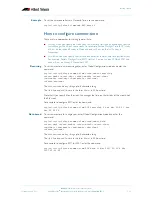
Getting Started
©2008 Allied Telesis Inc. All rights reserved.
1.10
AlliedWare Plus
TM
Operating System Software Reference C613-50003-00 REV E
Software Version 5.2.1
Default settings
When the switch first starts up with the AlliedWare Plus OS, it applies default settings and
copies these defaults dynamically into its running-config.
These default settings mean that the AlliedWare Plus OS:
■
encrypts passwords, such as user passwords
■
records log message priority in log messages
■
turns on jumbo frame support for all ports
■
turns on the telnet server so that you can telnet to the switch
■
enables the switch to look up domain names (but for domain name lookups to work, you
have to configure a DNS server)
■
turns off L3 multicast packet switching in the switch’s hardware. This prevents L3 multicasts
from flooding the switch’s CPU in its default state as an L2 switch
■
sets the maximum number of ECMP routes to 8
■
turns on RSTP on all ports. Note that the ports are not set to be edge ports
■
sets all the switch ports to access mode. This means they are untagged ports, suitable for
connecting to hosts
■
creates VLAN
1
and adds all the switch ports to it
■
allows logins on the serial console port
■
allows logins on VTY sessions (for telnet etc)
■
has switching enabled, so layer 2 traffic is forwarded appropriately without further
configuration
■
allocates all the routing table memory space to IPv4 routes (instead of IPv6 routes)
■
has ports set to autonegotiate their speed and duplex mode
■
has copper ports set to auto MDI/MDI-X mode
















































